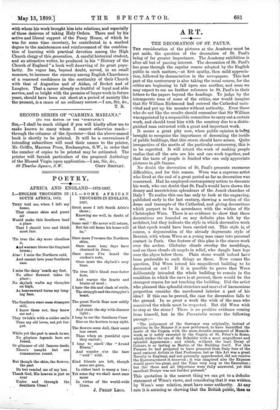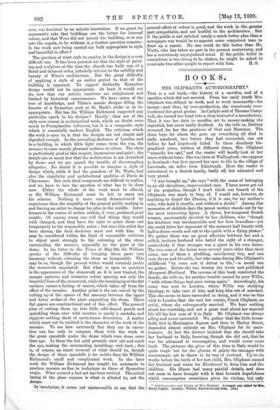ART.
'ME DECORATION OF ST. PAUL'S.
THE consideration of the pictures at the Academy must be put aside, the question of the decoration of St. Paul's being of far greater importance. The Academy exhibition is after all but of passing interest. The decoration of St. Paul's has gone through the regular course adopted by the English public in such matters,—at first apathy, then mild apprecia- tion, followed by denunciation in the newspapers. This last part of the controversy is also taking the usual course, for the critics are beginning to fall upon one another, and soon we may expect to see no further reference to St. Paul's in their letters to the papers beyond the headings. To judge by the• intemperate tone of some of the critics, one would imagine that Sir William Richmond had entered the Cathedral unin- vited and put up his mosaics without authority. Even those who do not like the results should remember that Sir William was appointed by a responsible committee to carry out a certain work, and should treat him with the courtesy due to a distin- guished man entrusted with a great and important work.
It seems a great pity now, when public opinion is being brought to recognise the importance of decorating the inside of public buildings, that this storm should have arisen. Quite irrespective of the merits of the particular controversy, this is to be regretted. It will retard the work of making people realise that all the arts are kin and can work together, and that the taste of people is limited who can only appreciate pictures in gilt frames.
No doubt the decoration of St. Paul's presents enormous difficulties, and for this reason. Wren was a supreme artist who lived at the end of a great period as far as decoration was concerned. Had he employed contemporary artists to decorate his work, who can doubt that St. Paul's would have shown the dreary and meretricious splendours of the Jesuit churches of Italy I To realise this one has only to look at the engraving, published early in the last century, showing a section of the dome and transepts of the Cathedral, and giving decorations which purport to be in accordance with the wishes of Sir Christopher Wren. There is no evidence to show that these decorations are founded on any definite plan left by the architect, but they indicate the style in which decorative work at that epoch would have been carried out. This style is, of course, a degeneration of the already degenerate style of Bernini, with whom Wren as a yoring man came into personal contact in Paris. One feature of this plan is the stucco work over the arches. Globular clouds overlap the mouldings, and on these clouds sit angels in relief, who dangle bare legs over the abyss below them. Plain stone would indeed have been preferable to such things as these. Now comes the question, Did Wren intend his magnificent building to be decorated or not? If it is possible to prove that Wren deliberately intended the whole building to remain in the condition in which the nave is at present, there would be the strongest reason for not touching the building. Did the artist who planned this splendid structure and marvel of harmonious proportion consider the uncoloured interior a part of his idea? If this can be proved, the case for decoration falls to the ground. In so great a work the wish of the man who conceived the whole must be respected. But did Wren wish to stop at the stone ? There is no positive evidence coming from himself, but in the Parentalia occurs the following
passage:—
" The judgement of the Surveyor was 'originally, instead of painting in the Manner it is now performed, to have beautified the inside of the Cupola with the more durable ornament of Mosaick- work, as is nobly executed in the Cupola of St. Peter's in Rome, which strikes the eye of the Beholder with a most magnificent and splendid Appearance ; and which, without the least Decay of Colours, is as lasting as Marble, of the Building itself. For this Purpose he had projected to have procured from Italy four of the most eminent Artiste in that Profession, but as this Art was a great Novelty in England, and not generally apprehended, did not receive the Encouragement it deserved ; it was imagined also the Expense would prove too great, and the Time very long in the Execution ; but tho' these and all Objections were fully answered, yet this excellent Design was not further pursued."
This quotation is the nearest thing we can get to a definite statement of Wren's views, and considering that it was written. by Wren's near relation, must have some authority. At any rate it is amusing as showing that the British public, then as now, was horrified by an artistic innovation. If we grant for argument's sake that buildings are the better for internal colour, and that Wren did not intend his building, or at any rate the cupola, to be without it, a further question remains : Is -the work now being carried out both appropriate in style and beautiful in effect The question of what style to employ in the design is a very difficult one. It has been pointed out that the style of paint- ing and sculpture at the time the church was built was of a florid and debased order, infinitely inferior to the nobility and beauty of Wren's architecture. But the great difficulty of applying a style of an earlier period to that of the building is apparent. To suggest distinctly Byzantine design would not be appropriate. At least it would not do, now that our artistic emotions are enlightened and limited by historical consciousness. We have eaten of the tree of knowledge, and Titian's mosaic designs filling the lunette of a Byzantine arch at St. Mark's strike us as in- appropriate. But has Sir William Richmond suggested any particUlar epoch in his designs I Hardly ; they are of the style now comon in ecclesiastical work, which no doubt owes much to Preraphaelite influence, but it is a composite style which is essentially modern English. The criticism which the work is open to, is that the designs are not simple and dignified enough. In the prevailing darkness of London and in a building in which little light comes from the top, the mosaics become merely pleasant surfaces of colour. The choir is particularly good in this respect, harmonious and quiet ; the details are so much lost that the architecture is not disturbed by them : and we are spared the trouble of disentangling allegories. No doubt it is possible to imagine a style of design which, while it had the grandeur of Mr. Watts, had also the simplicity and architectural qualities of Puvis de Chavannes. But such ideal compounds are difficult to realise, and we have to face the question of what has to be done now. Either the whole of the work must be effaced, or Sir William Richmond must be left to carry out his scheme. Nothing is more surely demonstrated by experience than the stupidity of the general public rushing in and forcing an artist to change his plan in the middle. Inter- ference in the course of action seldom, if ever, produced good results. Of course, every one will find things they would wish changed, and they have the right to point them out temperately to the responsible artist ; but once this artist has been chosen, the final decisions must rest with him. It may be considered within the limit of reasonable criticism to object most strongly to the colouring of the stone surrounding the mosaics, especially on the piers of the dome. In his letter to the Times of May 6th Sir William speaks of the difficulty of bringing these parts into harmony without colouring the stone as insuperable. This may be so, though the present writer would certainly prefer the stonework unpainted. But what is open to question is the appearance of the stonework as it is now treated, the meagre patterns and tentative colour marring not only the beautiful lines of the stonework, while the breakingup of the flat surfaces causes a feeling of unrest, which takes off from the effect of the mosaics. Another point is the one raised by the cutting .up of the spaces of flat masonry between the upper and lower arches of the piers supporting the dome. These flat spaces are constructional and of fine effect. The present plan of cutting them up into little odd-Shaped panels and sprinkling them over with rosettes is surely a mistake, and suggests nothing short of opera-house decoration. A matter which must not be omitted is the character of the work of the mosaics. To see how extremely fine they are in execu- tion one has only to compare them with the work in the great spandrils under the dome which were done some time ago. In these the flat gold grounds start out and catch the eye, making the surrounding mouldings sink back ; this is, of course, an exact reversal of what should be, though the design of these spandrils is far nobler than Sir William Richmond's small and complicated work. In the later work Sir William Richmond has taught his assistants to produce mosaics as fine in technique as those of Byzantine origin. What seemed a lost art has been revived. The actual laying of the glass squares is what is alluded to not the design.
In 'conclusion, it seems not unreasonable to say that the general effect of colour 4 good, and the work in the greater part sympathetic, and not hurtful to the architecture. But if the public is not satisfied surely a much better plan than a newspaper war would be to appoint some competent man to draw up a report. No one could do this better than Mr. Watts, who has taken no part in the present controversy, and has a notoriously unprejudiced mind. If the public belief in committees is too strong to be shaken, he might be asked to nominate two other people to report with him. H. S.







































 Previous page
Previous page